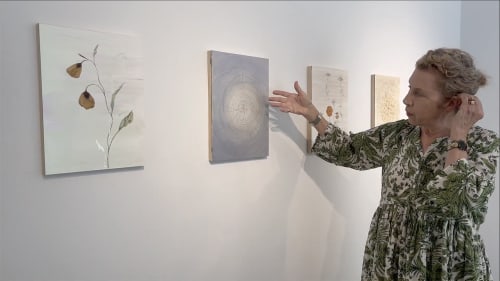The sublime is something that has interested me, not just as an artist within the history of art, but also as a person existing on the planet. Of course a sublime experience is so meaningful.
In this body of work, I see the sublime in microcosms, which could feel like a complete contradiction of terms. In my work, there is always nature and artifice, because that is the world we live in, but I use it as a tool. This little row of sequins captures the beauty of the texture of some sprout of grass. It’s artifice, but it helps me capture what I see of a sparkle or detail.
None of these can exist in nature as they are. I think it’s a misunderstanding that they are just a botanical study. They’re not. For example, these tulips weren’t really blue. I like to blur the distinction between what I do and what’s an actual collage botanical element. These are the stamen of the pasaflora that look a bit like stitching. It’s wet-on-wet watercolor because I like to see the fluidity of watercolor and how, if I let it be, it can actually capture some of the futility of the plant itself.
I started working on panels after I built my studio in the country. I look out and see all the plants that I’ve planted throughout the year, growing, blooming, dying, and feeding the birds in the winter. To me, it’s an attempt to replicate my feeling of existing in nature. So I couldn't create this effect on paper the way I wanted it to be, of constantly changing light.
These two have elements from Maria Sibylla Merian’s botanical studies. She was an amazing scientist in the 1700s. She traveled to Suriname to prove her belief that insects have sex and reproduce. The prevailing theory at that time was that they emerged fully formed out of the mud. So she went to Suriname and sat in the mud, proving her point. As a byproduct of this, she made the most incredible botanical renderings of nature.
This one is the sublime microcosm of a spiderweb that I saw at dawn one morning. It was just so big and fabulous with dewdrops like jewelry on it. It’s not a portrait of this spider web; it's more the idea of a spider web.
This one again feels like a botanical, but it’s not a plant that has ever existed in nature. The poppy petals, which are so gorgeous and detailed, don't come off that stem, and this is not how it looks in nature. It’s referencing an idea of a flower, not an actual flower. The gold leaf, which kind of disappears and then comes into view, is meant to feel like an idea of something that’s fleeting. - Marilla Palmer

